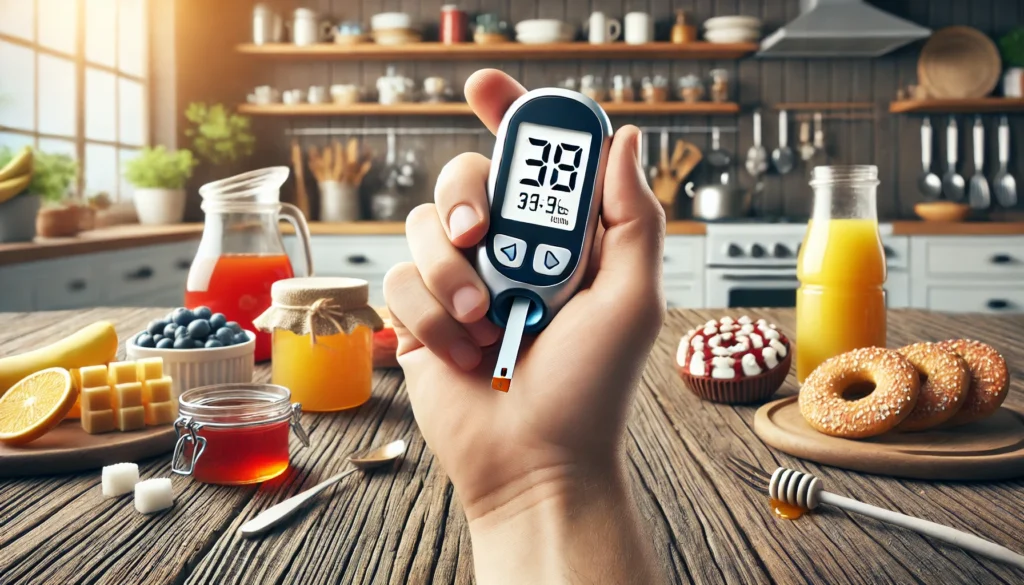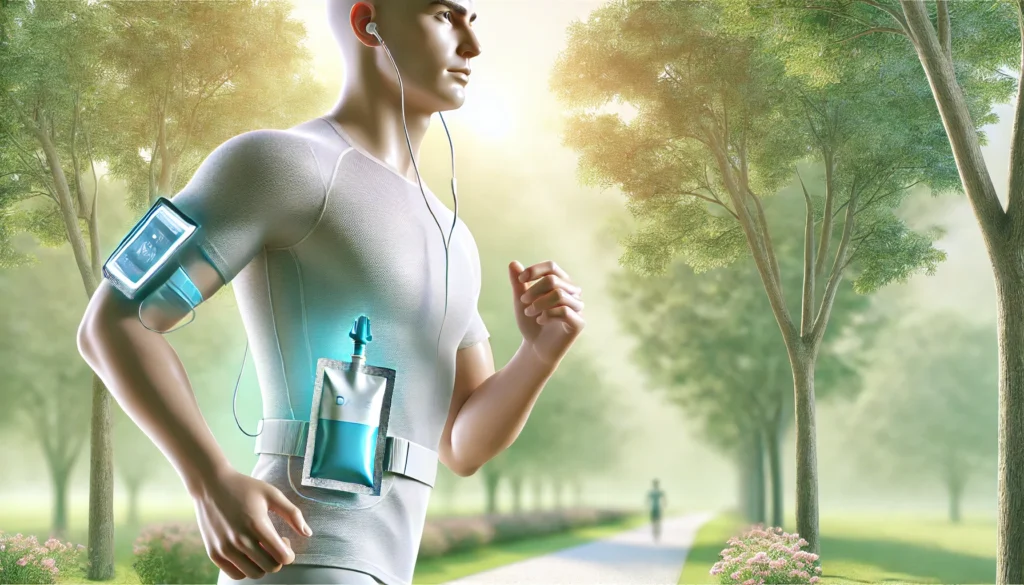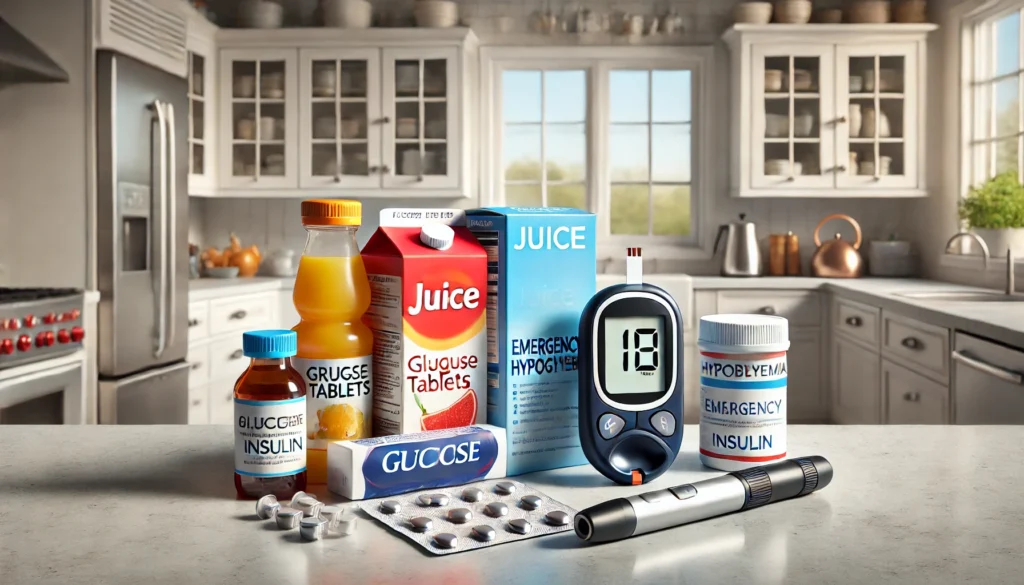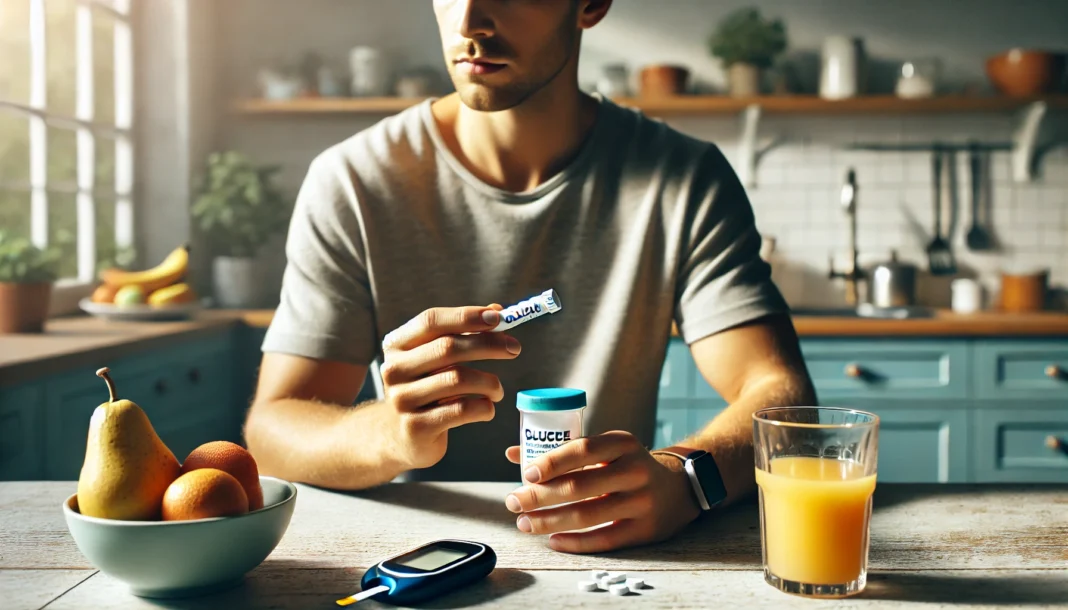Understanding Hypoglycemia: The Science Behind Low Blood Sugar Levels
Hypoglycemia, commonly referred to as low blood sugar, is a condition characterized by abnormally low levels of glucose in the bloodstream. Glucose is the body’s primary energy source, particularly for the brain, which relies heavily on a constant supply. When blood sugar levels fall below normal—typically under 70 mg/dL—it can lead to a cascade of physiological disruptions, ranging from mild symptoms like shakiness and sweating to severe consequences such as seizures, unconsciousness, or even death if not addressed promptly.
You may also like: How Diabetes Affects the Brain: Understanding Brain Fog, Memory Loss, and Mental Confusion from High Blood Sugar
The mechanism of hypoglycemia involves a mismatch between glucose availability and the body’s energy needs. This can occur due to several factors: too much insulin, inadequate food intake, delayed meals, excessive alcohol, or intense physical activity. People with diabetes, especially those using insulin or other glucose-lowering medications, are at significantly higher risk. However, even those without diabetes can experience a phenomenon known as reactive hypoglycemia, where blood sugar drops a few hours after eating due to excessive insulin release. Many individuals ask, “Is reactive hypoglycemia dangerous?” While it typically isn’t life-threatening, the symptoms can be distressing and may signal underlying metabolic concerns that deserve attention.
The body has several built-in mechanisms to counteract falling glucose levels. The pancreas releases glucagon, the liver increases glucose production, and the adrenal glands secrete adrenaline. These responses collectively raise blood sugar fast when needed. But in people with diabetes or impaired glucose regulation, these responses may be delayed or blunted, necessitating external intervention. Knowing how to treat hypoglycemia quickly and safely becomes crucial in such scenarios. Furthermore, having a low blood sugar levels chart on hand can help individuals recognize when blood sugar levels enter dangerous territory—particularly readings like blood sugar 40 or blood sugar 50, which require immediate action.

Recognizing the Signs of Hypoglycemia Before It Becomes Dangerous
Catching the signs of hypoglycemia early can be the difference between a manageable episode and a life-threatening emergency. Symptoms generally appear in three progressive categories: adrenergic (or neurogenic), neuroglycopenic, and severe. Adrenergic symptoms are triggered by the body’s response to falling blood sugar and include sweating, trembling, rapid heartbeat, and feelings of anxiety. These signs often serve as the body’s early warning system, and they signal the need to act before glucose levels dip further.
As hypoglycemia worsens, neuroglycopenic symptoms emerge, indicating a shortage of glucose in the brain. These include confusion, blurred vision, irritability, difficulty concentrating, slurred speech, and dizziness. At this stage, individuals may still be able to treat themselves but are at greater risk of impaired judgment. If glucose levels continue to fall without correction, the result may be seizures, unconsciousness, or even coma. This is when blood sugar levels like 40 or 50 enter critical ranges, and knowing when to call 911 for low blood sugar levels becomes vital.
Understanding these signs is particularly important in vulnerable populations, such as older adults, children, or individuals with hypoglycemia unawareness—a condition in which the body no longer exhibits early warning symptoms. In such cases, regular monitoring and proactive management are essential. One of the lesser-known symptoms of low blood sugar is feeling cold or clammy. This leads to frequent questions such as: does low blood sugar make you cold? Indeed, it can. A drop in glucose triggers adrenaline release, which may cause vasoconstriction, leading to a sensation of coldness even in warm environments.
Heart rate also becomes an indirect marker of hypoglycemia, especially when accompanied by other signs. A racing or irregular heartbeat is often one of the earliest responses to falling blood sugar, especially in individuals who are highly sensitive to these fluctuations. If you notice a consistently low blood sugar heart rate correlation, it’s worth discussing this pattern with your healthcare provider to adjust your management strategy accordingly.
Emergency Response: How to Bring Blood Sugar Up Quickly and Safely
Once symptoms of hypoglycemia are identified, prompt action is crucial. The goal is to raise blood sugar fast enough to restore normal function without overshooting and causing hyperglycemia. The cornerstone of immediate treatment is the 15-15 rule for hypoglycemia, often simplified as the 15 15 rule or even referred to as the 15 15 15 rule hypoglycemia protocol. This method involves consuming 15 grams of fast-acting carbohydrates, waiting 15 minutes, and rechecking blood sugar levels. If levels remain low, repeat the process.
Examples of fast-acting carbohydrates include glucose tablets, fruit juice, regular (non-diet) soda, honey, or hard candies. Glucose tablets are preferred because they offer a precise dosage and are rapidly absorbed, making them especially useful for those who need to raise blood sugar fast. People frequently wonder what to eat when you have low blood sugar. The answer depends on the context, but the initial treatment should always involve simple carbs. After stabilizing, it’s advisable to follow up with a complex carbohydrate or protein source to sustain levels.
In severe cases—particularly if someone is unconscious or unable to swallow—injectable glucagon or nasal glucagon (Baqsimi) becomes essential. This is when having a hypoglycemia protocol in place is critical, especially for individuals with diabetes. Family members and caregivers should be trained in administering glucagon and know exactly when to call 911 for low blood sugar levels. A good rule of thumb is that if someone becomes unconscious or their blood sugar drops below 50 and does not respond to oral treatment, emergency services should be contacted immediately.
Even in moderate situations, people often find themselves asking, “Can you die from low blood sugar in your sleep?” or “Can you die from hypoglycemia if untreated?” The unfortunate answer is yes. Nocturnal hypoglycemia is especially dangerous because symptoms can go unnoticed until it’s too late. Individuals with a history of severe hypoglycemia should use continuous glucose monitors (CGMs) with alarms or have a bed partner trained to recognize signs of nighttime lows. Monitoring early morning low blood sugar patterns can help prevent overnight episodes and allow for adjustment of evening insulin or medication doses.
What to Keep on Hand for Low Blood Sugar: Building Your Emergency Toolkit
Preparation is one of the most effective ways to prevent complications from hypoglycemia. Knowing what to keep on hand for low blood sugar can help you or a loved one respond swiftly and effectively. The essentials should include glucose tablets or gels, a fast-acting carbohydrate like juice boxes or sugar packets, a glucagon emergency kit, and a portable blood glucose monitor or CGM. Many individuals also benefit from keeping snacks with both carbs and protein—such as peanut butter crackers or granola bars—in their bag, car, or bedside drawer.
A low blood sugar levels chart is another useful tool, especially for those new to managing blood sugar fluctuations. This chart can guide decision-making and clarify when symptoms warrant treatment, observation, or emergency intervention. For instance, understanding what to do at blood sugar 76, blood sugar 77, or blood sugar 80 can help determine whether action is needed or if a simple snack will suffice. Is 80 low blood sugar? Not usually, but for someone accustomed to higher levels, it can produce symptoms and should be addressed with caution.
Some individuals, especially those on insulin or sulfonylureas, may benefit from wearing medical alert bracelets indicating their diabetes status and treatment regimen. This is critical in situations where they may be unable to communicate. Technology also offers support. Many CGMs now feature customizable alarms that alert users to impending lows—some even sync with smartwatches or smartphones. Setting a low threshold alert (such as for blood sugar 54 or below) can be life-saving.
Equally important is educating those around you. Friends, family, coworkers, and school staff should be familiar with how to treat hypoglycemia and know your hypoglycemia protocol. Having a written plan, laminated and accessible, can prevent panic and guide timely treatment. This proactive approach doesn’t just improve safety; it fosters independence and peace of mind for those living with blood sugar variability.
Preventing Hypoglycemia Before It Starts: Daily Strategies for Stability
While emergency response is crucial, long-term management of blood sugar is just as important. Preventing hypoglycemia begins with understanding your body’s unique patterns, medication interactions, and lifestyle variables. One of the most effective strategies is consistency—maintaining regular meal times and carbohydrate intake, especially for those using insulin or other glucose-lowering drugs. Skipping meals or delaying eating can disrupt the delicate balance between glucose supply and demand, making blood sugar drops more likely.
Understanding how to avoid low sugar levels also involves adjusting physical activity appropriately. Exercise increases insulin sensitivity and depletes glucose stores, which, if not properly managed, can cause hypoglycemia during or after physical exertion. Pre-workout snacks or adjusting insulin dosages around periods of activity are often necessary. Those experiencing early morning low blood sugar should evaluate their evening meal composition, nighttime insulin doses, or consider using CGMs with predictive alarms that monitor drops during sleep.
For those with reactive hypoglycemia, the strategy shifts slightly. Here, the goal is to regulate insulin secretion in response to food intake. Meals rich in fiber, healthy fats, and proteins help slow glucose absorption and prevent insulin spikes. Frequent small meals may also stabilize blood sugar throughout the day. Asking “How to get back my blood sugar to a safe level and keep it there?” becomes less about immediate fixes and more about lifestyle structure, balanced macronutrient distribution, and timing.
Medication adjustments can also play a central role. Your healthcare provider may change the type, dose, or timing of medications based on hypoglycemia patterns. For some individuals, a review of whether a current medicine for hypoglycemia prevention is working effectively may be warranted. Some newer diabetes treatments have a lower risk of causing lows and might be more appropriate, especially for older adults or those living alone.
Finally, structured education and empowerment are fundamental. Knowing how to bring blood sugar up, when to call 911 for low blood sugar levels, and what to eat when you have low blood sugar equips individuals with the confidence to handle crises and reduce future risk. Education is not just for the patient but for family members, caregivers, and even employers. A shared understanding builds a safer, more supportive environment.
The Long-Term Risks of Untreated Hypoglycemia
While the immediate effects of hypoglycemia are often more visible, its long-term implications can be just as serious. Repeated episodes of severe low blood sugar can lead to hypoglycemia unawareness, where the body no longer signals an impending drop. This condition is dangerous because it removes the body’s built-in alert system, increasing the risk of accidents, cognitive impairment, and in extreme cases, death. For individuals wondering, “Can you die from hypoglycemia?” or “Can you die from low blood sugar in your sleep?”—the unfortunate reality is yes, especially when left unmanaged or ignored.
Chronic low blood sugar can also impair cognitive function over time, particularly in older adults. Studies have linked repeated hypoglycemic episodes with increased risk of dementia, memory loss, and reduced executive functioning. Children and adolescents are not immune either. Hypoglycemia during brain development stages can interfere with academic performance, emotional regulation, and overall neurological maturation.
Cardiovascular risks also increase with severe hypoglycemia. Rapid changes in blood sugar can trigger arrhythmias, raise blood pressure, and increase the risk of cardiac events. Many individuals report feeling a pounding heart or fluttering sensation during a hypoglycemic episode, raising concerns about the connection between low blood sugar heart rate fluctuations and long-term cardiac stress.
For people living with diabetes, managing hypoglycemia becomes part of a delicate balancing act. If the fear of lows leads to keeping blood sugar levels too high, it raises the risk of long-term complications like neuropathy, retinopathy, and kidney disease. Therefore, comprehensive care must consider both high and low extremes, making regular monitoring, open dialogue with healthcare providers, and customized care plans indispensable.
The Role of Monitoring and Technology in Preventing Dangerous Drops
With advances in diabetes technology, individuals now have more tools than ever to help prevent hypoglycemia. Continuous glucose monitors (CGMs) provide real-time feedback, alerting users to rising or falling blood sugar levels before symptoms appear. These devices have revolutionized how we understand and treat hypoglycemia, offering insights into patterns that traditional fingerstick methods often miss. For instance, if your blood sugar tends to fall to 76 or 77 in the early morning hours, a CGM can help you identify contributing factors—like nighttime insulin peaks or inadequate bedtime snacks.
Many CGMs also feature trend arrows and predictive alerts. These tools allow users to take preemptive steps to raise blood sugar fast before it becomes a crisis. Alarms can be set to go off at thresholds like blood sugar 54 or 50, providing a crucial window for action. Moreover, integration with insulin pumps or closed-loop systems creates a feedback mechanism that can automatically adjust insulin delivery to minimize lows. These systems represent a major breakthrough in reducing the burden of daily management.
However, technology is only as effective as the education that supports its use. People must still understand how to interpret data, apply the 15 15 rule for hypoglycemia treatment, and recognize when to call for emergency support. Education also helps individuals differentiate between transient dips, which may not require intervention, and true hypoglycemic episodes requiring immediate action.
For those without diabetes but who experience reactive hypoglycemia, wearable glucose monitors are becoming increasingly popular. These devices help users identify which meals or activities precipitate a drop, enabling them to modify behavior accordingly. Is reactive hypoglycemia dangerous? Not typically in the immediate sense, but if left unmanaged, it can indicate underlying metabolic dysfunction or insulin resistance, which may eventually progress to type 2 diabetes.
Ultimately, integrating technology with personalized care plans, nutritional guidance, and regular medical check-ins provides a holistic approach to preventing hypoglycemia and promoting long-term stability.

Frequently Asked Questions (FAQ) on Low Blood Sugar and Hypoglycemia
1. What should I keep on hand for low blood sugar?
To effectively manage low blood sugar, always carry a source of fast-acting glucose, such as glucose tablets, fruit juice, or hard candy. Having a small snack that contains both protein and carbohydrates, like peanut butter crackers, can help sustain blood sugar levels after initial treatment. It’s also wise to have a low blood sugar levels chart handy to track patterns and better understand your body’s response. If you use insulin or have frequent hypoglycemic episodes, wearing a medical ID bracelet can alert others in case of an emergency. Lastly, keeping a glucagon emergency kit is crucial for severe hypoglycemia when immediate medical intervention is required.
2. Can you die from low blood sugar in your sleep?
Yes, severe hypoglycemia during sleep can be life-threatening if not addressed. A dangerously low blood sugar level, such as blood sugar 40 or blood sugar 50, can lead to seizures, loss of consciousness, or even coma. Symptoms like night sweats, nightmares, or an increased heart rate may indicate early morning low blood sugar. If you experience frequent nocturnal hypoglycemia, consider adjusting your evening insulin dose or eating a bedtime snack rich in complex carbohydrates. In extreme cases, when to call 911 for low blood sugar levels includes instances where a person is unresponsive or having a seizure.
3. How can I bring my blood sugar back up quickly?
The fastest way to raise blood sugar fast is by consuming 15-20 grams of fast-acting carbohydrates, such as a half-cup of juice or a glucose tablet. Following the 15 15 rule for hypoglycemia, check your blood sugar after 15 minutes and repeat if necessary. Avoid foods high in fat, as they slow glucose absorption. If your blood sugar 54 or lower, immediate action is required to prevent further complications. If you are unable to swallow or your symptoms worsen, seek emergency assistance promptly.
4. What is the 15 15 rule, and how does it help treat hypoglycemia?
The 15 15 rule diabetes strategy involves consuming 15 grams of carbohydrates, waiting 15 minutes, and rechecking blood sugar levels. If levels remain low, repeat the process. This method is particularly useful when treating hypoglycemia with a structured approach. However, for individuals with blood sugar 76 or blood sugar 77, additional snacks may be necessary to maintain stable levels. The 15 15 15 rule hypoglycemia approach is an effective way to avoid overcorrecting low blood sugar and experiencing spikes later.
5. What should I eat when I have low blood sugar?
For immediate relief, consume simple carbohydrates like honey, sugar cubes, or a small amount of soda. After stabilizing, eat a balanced meal containing protein and complex carbohydrates to prevent another drop. Understanding how to avoid low sugar levels includes incorporating fiber-rich foods into your diet, which help slow glucose absorption. If your blood sugar 80 or slightly below, a small snack may suffice. Tracking your meals can help identify patterns contributing to hypoglycemia and improve long-term management.
6. Is reactive hypoglycemia dangerous?
Yes, reactive hypoglycemia can be concerning, especially if left unmanaged. This condition occurs when blood sugar drops after eating, often due to excessive insulin release. Recognizing symptoms like dizziness, sweating, and low blood sugar heart rate fluctuations is essential for early intervention. To prevent episodes, opt for low-glycemic index foods and avoid high-sugar meals that trigger insulin spikes. If you experience frequent episodes, consult a healthcare provider about potential medicine for hypoglycemia and dietary adjustments.
7. Can low blood sugar make you feel cold?
Yes, low blood sugar can make you feel cold due to the body’s stress response. When glucose levels drop, the body releases adrenaline, which can cause shivering, paleness, and cold sweats. These symptoms are often accompanied by confusion, fatigue, and irritability. Does low blood sugar make you cold all the time? Not necessarily—while some individuals are more sensitive, symptoms vary. Dressing in layers and managing blood sugar stability can help minimize temperature-related discomfort.
8. How can I prevent hypoglycemia from happening frequently?
Understanding how to prevent hypoglycemia involves maintaining a consistent eating schedule and monitoring blood sugar levels closely. Eating balanced meals with protein, fiber, and healthy fats helps prevent rapid glucose fluctuations. The hypoglycemia protocol often includes adjusting insulin dosages, increasing meal frequency, and tracking food intake. If you experience frequent blood sugar 76 or lower readings, speak to a healthcare provider about medication adjustments. Awareness of early symptoms is key to preventing severe episodes.
9. How do I manage low blood sugar in the early morning? Early morning low blood sugar can result from overnight insulin use or prolonged fasting. A bedtime snack containing protein and complex carbohydrates may help maintain stable levels overnight. Checking your blood sugar before bed can help identify trends that may require adjustments in medication or dietary habits. If blood sugar 54 or lower upon waking, immediate treatment is necessary to avoid severe symptoms. Adjusting your insulin regimen with the help of a doctor can reduce morning hypoglycemia occurrences.
10. Can you die from hypoglycemia if left untreated?
Yes, severe hypoglycemia can be fatal if not treated promptly. Blood sugar 40 or lower can lead to coma, seizures, and even death. Can you die from low blood sugar? The risk increases if the body does not receive enough glucose to function. If someone is unconscious due to hypoglycemia, emergency glucagon administration is essential. When to call 911 for low blood sugar levels includes situations where a person is unresponsive, experiencing convulsions, or cannot take oral glucose independently.

Bringing It All Together: Safe and Sustainable Ways to Treat and Prevent Hypoglycemia
Hypoglycemia may be common, but that does not make it benign. It is a medical condition with immediate dangers and long-term implications if not managed correctly. The good news is that with science-backed strategies, proactive planning, and a solid understanding of how the body responds to glucose fluctuations, hypoglycemia can be both treated effectively and prevented in the long term.
For those who experience frequent drops, knowing how to treat hypoglycemia quickly—using the 15-15 rule or, in more severe cases, emergency glucagon—is life-saving knowledge. Being equipped with a hypoglycemia protocol, having an emergency glucose source nearby, and educating those around you ensures that low blood sugar episodes are addressed safely and swiftly. Creating a daily routine around balanced meals, appropriate medications, and tailored physical activity also serves as a foundational strategy in how to avoid low sugar levels altogether.
It’s equally essential to acknowledge the role of awareness. Whether you’re wondering if blood sugar 76 or blood sugar 80 is cause for concern, or if you’re navigating through the nuances of what to eat when you have low blood sugar, the key is being in tune with your own physiology. The ability to recognize symptoms—such as feeling cold or noticing changes in heart rate—can prompt timely action and reduce complications. Education transforms fear into confidence.
Technology serves as an invaluable ally, especially for those at risk of dangerous nighttime drops. For individuals worried about whether you can die from low blood sugar in your sleep, CGMs offer peace of mind, setting off alarms before levels become critical. Even if you’re not managing diabetes, using tools to track glucose patterns—especially in reactive hypoglycemia—helps you identify the triggers and learn how to get back your blood sugar without overcorrecting.
Ultimately, the goal is not just to survive hypoglycemia but to thrive despite it. With the right knowledge, tools, support system, and healthcare guidance, you can live safely and confidently. Managing hypoglycemia isn’t just about quick fixes; it’s about building a lifestyle that keeps your blood sugar stable, your body energized, and your mind at ease.
low blood sugar symptoms adults, how to stabilize blood glucose, best foods for blood sugar recovery, glucose emergency kit essentials, glucagon injection use, signs of sugar crash, blood glucose regulation, dangers of insulin overdose, glucose tablets vs juice, real-time glucose tracking, low blood sugar management tips, blood sugar and exercise, preventing diabetic hypoglycemia, continuous glucose monitoring benefits, how insulin affects blood sugar, bedtime snacks for glucose stability, early signs of sugar drop, understanding reactive hypoglycemia, when to seek emergency care for hypoglycemia, food choices for blood sugar control
Further Reading:
Treatment of Mild Hypoglycemia
Detection, Prevention, and Treatment of Hypoglycemia in the Hospital
Disclaimer: The content published on Better Nutrition News (https://betternutritionnews.com) is for informational and educational purposes only. It is not intended as a substitute for professional medical advice, diagnosis, or treatment. Always seek the guidance of a qualified healthcare professional before making any changes to your diet, nutrition, or wellness practices. The opinions expressed by authors and contributors are their own and do not necessarily reflect those of Better Nutrition News.
Better Nutrition News and its affiliates make no representations or warranties regarding the accuracy, completeness, or reliability of the information provided. We disclaim all liability for any loss, injury, or damage resulting from the use or reliance on the content published on this site. External links are provided for reference purposes only and do not imply endorsement.



